It’s hard to think of Scotland without conjuring up an image of the iconic Edinburgh Castle. Instantly recognisable, taking a trip to see the castle is often top of the list when you visit Scotland… and it’s easy to see why!
So, take a walk up the Royal Mile to discover stories of kings and queens, jewels and ghosts, Edinburgh Castle has it all and we’re here to cover it right here, right now!
Edinburgh Castle history
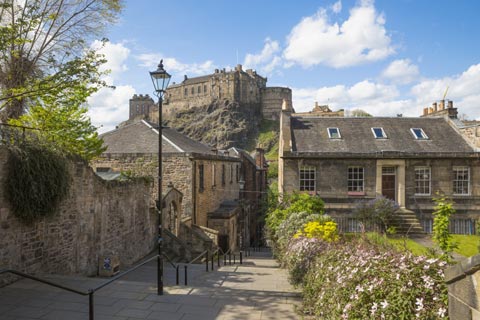
It’s fair to say that Edinburgh Castle has a rich and colourful history. Two frequently asked questions are ‘When was Edinburgh Castle built?’ and ‘How old is Edinburgh Castle?’ and the answer is 1103 and over 900 years old, respectively! Over the years, it’s taken on several different guises, including as a royal home, military garrison and even a prison.
As well as playing host to Mary Queen of Scots and her second husband, Henry Stewart (Lord Darnley), Edinburgh Castle also survived the Jacobite Rising in 1689. It was the location of an escape by French Prisoners of War in 1811 and even treated Luftwaffe pilots who had been shot down in 1939. That old saying ‘if only the walls had ears’ has never been so poignant as when we think about Edinburgh Castle.
Is Edinburgh Castle built on a volcano?
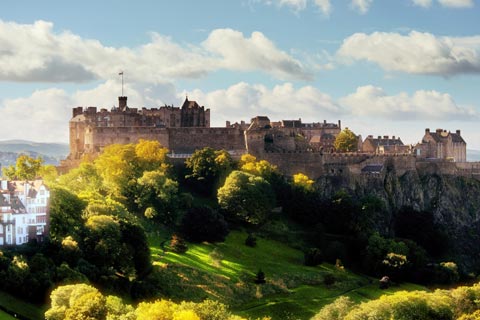
When you visit the city of Edinburgh, you can’t help but notice the magnificent castle sitting atop its rocky base, also known as castle rock Edinburgh. This rock is the plug of an ancient volcano and is estimated to be approximately 350 million years old. Edinburgh as a city is the home of not just one, but 3 volcanoes – the other two are now the home of Calton Hill and Arthur’s Seat.
From a strategic point of view, having a castle situated on the ground much higher than the rest of the town will be beneficial when it comes to being alerted to any incoming attacks and therefore mounting an appropriate response. In more modern times where such battles are not so commonplace,
Edinburgh Castle being up high gives you great views of Edinburgh and the Forth Estuary.
Edinburgh Castle Guide
Are you planning to visit Edinburgh? If so, you should certainly include a visit to this mighty fortress. Here are some of the sights you can expect to see when you walk over the drawbridge and through the imposing Portcullis Gate.
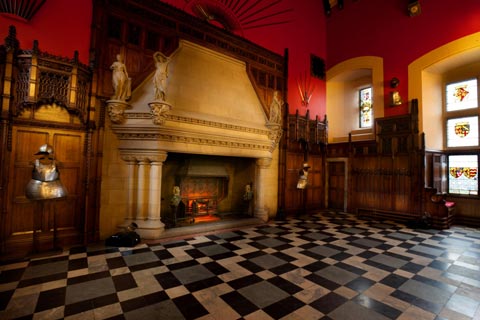
The Great Hall
We’ll start in Crown Square where you’ll see The Great Hall. Once part of the Royal residence, it’s been a location for banquets, events, a barracks following a takeover by Oliver Cromwell and even a hospital. It now serves as a place to showcase weaponry found in the castle.
When it comes to appearances, the mere word ‘hall’ doesn’t do this room justice, with dramatic wooden beams that sit on carved stones. Can you spot any familiar looking carvings? Keep a lookout for a thistle, the national flower of Scotland.
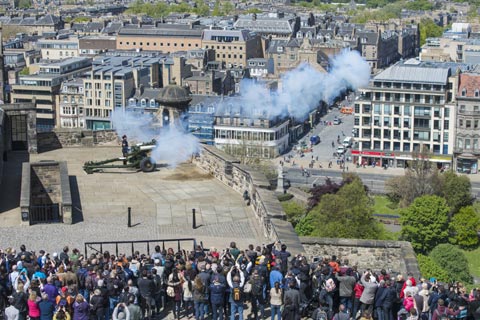
One O’Clock Gun
Edinburgh Castle is also home to The One o’Clock Gun which, as the name suggests, is fired at one o’clock everyday bar Sunday (and a couple of other public holidays).
The idea of firing the gun originally came from Paris, thanks to businessman John Hewitt. The gun was first fired in 1861 and was designed as a time signal for ships in the River Forth.
The gun is fired from the Mills Mount Battery.
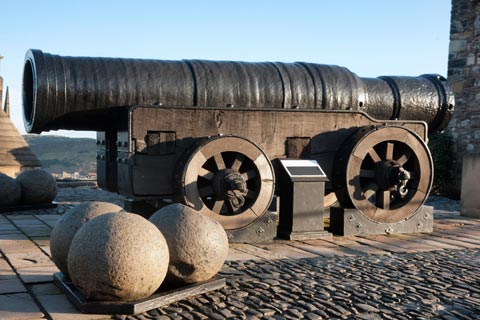
Mons Meg
On the subject of guns, look out for Mons Meg. This six-tonne siege gun was presented to King James II in 1457 and is named after the Belgian town where it was constructed. It could hurl a 150kg cannonball up to 2 miles making this one of the most feared weapons of its day.
Mons Meg is situated outside St Margaret’s Chapel, built by King David I for his mother, Queen Margaret. The chapel is the oldest building in Edinburgh and is now a venue for happy occasions such as weddings and christenings – what a legacy to leave.
Edinburgh Castle facts
There’s so much known about all the different aspects of Edinburgh Castle that it would be impossible to list them all here. Instead, we’ve picked out some of our favourite snippets of information to whet your appetite, starting with the spectacular Scottish Crown Jewels.
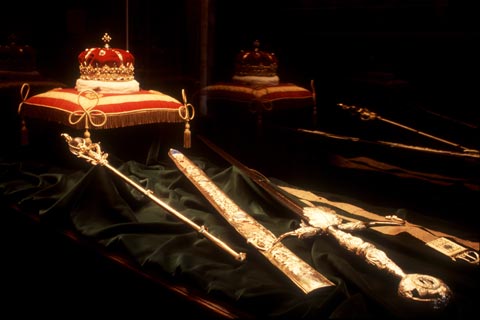
Honours of Scotland
A Crown, Sceptre and Sword of State make up the ‘Honours of Scotland’, also known as the Scottish Crown Jewels. They were used at the coronation of Mary Queen of Scots and then her son and grandson in subsequent years. To find out more about the time they managed to go missing, keep reading…
We couldn’t mention the Honours of Scotland without also talking about the Stone of Destiny. Also used for coronations of none other than Macbeth, the Stone of Destiny is also displayed in the Crown Room at Edinburgh Castle.
Ghostly Connections
However, it’s not just jewels that live in Edinburgh Castle… it’s said that some ghosts do too. From prisoners to a headless drummer, keep your eyes peeled when you visit in case a ghostly apparition decides to make an appearance.
Tunnels underneath the castle are also thought to be the resting place of the Young Piper Boy, who was tasked with entering some newly discovered tunnels. He played his pipes as a method to help mark out their locations before mysteriously disappearing. No trace of the boy was ever found, but from time to time, the eerie sound of the pipes can be heard – will your visit to the castle be accompanied by your very own musical recital?
Edinburgh castle facts for kids
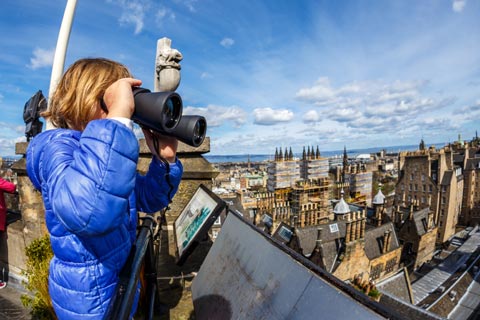
We couldn’t leave out the littlest family members, so here are some facts we’ve dug out just for them! If your child enjoys a night out at the fireworks, they may be interested to know that the very first fireworks display in Scotland was carried out at a jousting tournament at the castle way back in 1507.
Fireworks have been lighting up our skies ever since, delighting children of all ages (even the bigger children)!
Childhood Games
Then we come to the popular childhood game of hide and seek… it turns out that Edinburgh Castle was the location for a fairly major hide and seek game involving the Scottish Crown Jewels. Whilst nowadays they are out on show for people far and wide to come and admire, they got lost in the castle for over 100 years!
After being put in a chest after the ‘Treaty of Union’ in 1707, it wasn’t until Sir Walter Scott found them again in 1818 that they were remembered. We can’t imagine forgetting about such a real-life treasure!
Planning your visit
If you’ve decided you want to visit one of Scotland’s most famous castles, we’ve put together some information that you may find helpful.
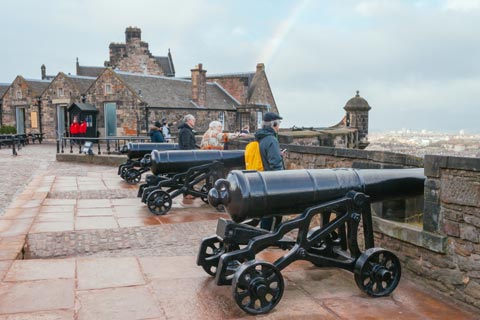
Edinburgh Castle Opening Times
The opening times will depend on when you plan to visit according to the season. The summer season is from April through to September when the castle opens at 9:30am and closes at 5pm.
The winter season runs from the start of October to the end of March, with reduced opening hours of 10am to 4pm.
We advise you to check the official website before booking as sometimes the castle can be closed. You are advised to allow a couple of hours for your visit. Currently, you need to book a 30-minute slot for your arrival to reduce the potential for queuing.
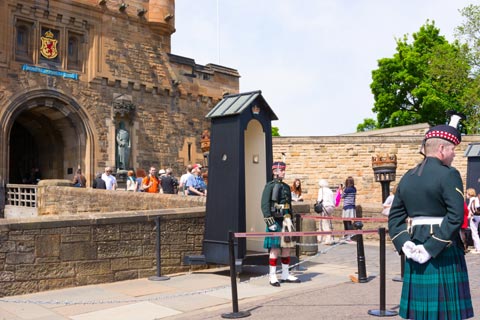
How to buy Edinburgh Castle Tickets
The type of ticket you purchase will depend on your circumstances. As well as standard tickets, you can also buy tickets for children and families.
There is also the option to buy concession tickets – restrictions apply here. See the Edinburgh Castle website for more.
Are you a member of Historic Scotland? If so, you’ll be able to take advantage of free entry, whilst members of English Heritage, Manx or Cadw will get half-price admission in the first year of membership, with free access granted upon membership renewal.
Edinburgh Castle Tour with Scottish Tours
Has all this reading got you in the mood for visiting Edinburgh Castle for yourself? We think that the easiest and most enjoyable way to take in all Edinburgh Castle has to offer is to book yourself on one of our dedicated tours, which includes a visit.
We’ve got a wide range of tours available on our website, meaning there’s sure to be something that fits your budget and requirements. Book your Scotland Tour now.

